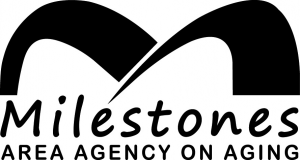July 13, 2020
Prevent Elder Abuse: Keep in Touch and Keep Watch
 By Sonita Oldfield-Carlson
By Sonita Oldfield-Carlson
Marketing and Public Relations
Milestone’s Area Agency on Aging
Approximately one in ten Americans aged 60+ have experienced some form of elder abuse. Some estimates range as high as 5 million elders who are abused each year. One study estimated that only 1 in 14 cases of abuse are reported to authorities. Abusers are both women and men. In almost 60% of elder abuse and neglect incidents, the perpetrator is a family member. Two-thirds of perpetrators are adult children or spouses. Perpetrators also include other family members, as well as staff at nursing homes, assisted living, and other facilities.
Elder abuse includes physical abuse, emotional abuse, sexual abuse, exploitation, neglect, and abandonment.
- Physical abuse means inflicting physical pain or injury upon an older adult.
- Sexual abuse means touching, fondling, intercourse, or any other sexual activity with an older adult, when the older adult is unable to understand, unwilling to consent, threatened, or physically forced.
- Emotional abuse means verbal assaults, threats of abuse, harassment, or intimidation.
- Confinement means restraining or isolating an older adult, other than for medical reasons.
- Isolation involves restricting visits from family and friends or preventing contact via telephone or mail correspondence.
- Abandonment involves desertion by anyone who assumed caregiving responsibilities for an adult.
- Passive neglect is a caregiver’s failure to provide an older adult with life’s necessities, including, but not limited to, food, clothing, shelter, or medical care.
- Willful deprivation means denying an older adult medication, medical care, shelter, food, a therapeutic device, or other physical assistance, and exposing that person to the risk of physical, mental, or emotional harm—except when the older, competent adult has expressed a desire to go without such care.
- Financial exploitation means the misuse or withholding of an older adult’s resources by another.
- Self-neglect involves seniors or adults with disabilities who fail to meet their own essential physical, psychological or social needs, which threatens their health, safety, and well-being. This includes failure to provide adequate food, clothing, shelter, and health care for one’s own needs.
Elders who have been abused have a 300% higher risk of death when compared to those who have not been mistreated. Social isolation and mental impairment (such as dementia or Alzheimer’s disease) are leading factors that make older adults vulnerable to abuse.
Strong supports and strong social connections are critical to preventing elder abuse, neglect, and exploitation, and supporting survivors. Yet many of these supports and connections are being strained by the physical distancing measures we are all taking to slow the spread of COVID-19. Even as the country begins to reopen, many older adults who face a higher risk of serious illness will need to continue taking additional precautions such as
staying at home.
We can all do our part to maintain the bonds of social connection within our communities while we are physically apart by keeping in touch and keeping watch. Know the signs of abuse:
- Physical abuse, neglect, or mistreatment: Bruises, pressure marks, broken bones, abrasions, burns
- Emotional abuse: Unexplained withdrawal from normal activities, a sudden change in alertness, or unusual depression; strained or tense relationships; frequent arguments between the caregiver and older adult.
- Financial abuse: Sudden changes in financial situations.
- Neglect: Bedsores, unattended medical needs, poor hygiene, unusual weight loss, appearing hungry, malnourished, disoriented or confused.
- Verbal or emotional abuse: Belittling, threats, or other uses of power and control by individuals.
Report concerns. Most states have penalties for those who victimize older adults. Increasingly, across the country, law enforcement officers and prosecutors are trained on elder abuse and ways to use criminal and civil laws to bring abusers to justice.
If an older adult is in immediate, life-threatening danger, call 911. Anyone who suspects that an older adult is being mistreated can contact the Elder Rights Specialist at Milestones Area Agency on Aging at 1-855-410-6222.
Sources: National Adult Protective Services Assoc. https://www.napsa-now.org/get-informed/
National Council on Aging https://www.ncoa.org/public-policy-action/elder-justice
USC Center on Elder Mistreatment https://eldermistreatment.usc.edu/weaad-home/
Sonita Oldfield-Carlson is Marketing and Public Relations Coordinator at Milestones Area Agency on Aging. She can be reached at (563) 484-3147.
Filed Under: Community, Health & Wellness, News
Trackback URL: https://www.50pluslife.com/2020/07/13/prevent-elder-abuse-keep-in-touch-and-keep-watch/trackback/


